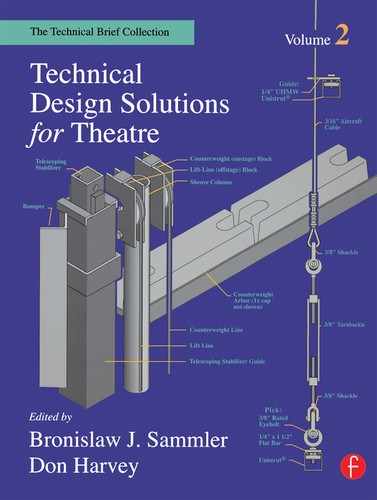A Self-paging Cable Tray |
Loren Schreiber |
Distributing power to a wagon or slip-stage is problematic at best. When the distribution system includes a mix of fluid-power hoses and electrical, control, and audio cables, paging the bundle as the wagon moves can be a challenge. Some traditional methods, particularly those that use carrier chains or self-retracting cable reels, are expensive. Others like festooning, require complex rigging, which is not always an option especially if the scenery is too low to hide the system. A simple, inexpensive solution suitable in many situations is the self-paging cable tray described here. It can be built with simple hand tools and from materials commonly found around the shop: a few boards, a couple of strap hinges, a caster, and miscellaneous nuts and bolts.

FIGURE 1: THE SELF-PAGING CABLE TFL4Y — PLAN VIEW & CASTER DETAIL
As shown above in plan view, the tray is nothing more than a pair of wooden channels joined by a strap hinge and two pieces of steel bar to form an articulated arm. At the “wrist,” the arm is hinged to the wagon: and at the “shoulder,” to a convenient point offstage. The width and depth of the channels depends on the size and quantity of the cables or hoses that will ride in the tray. The length of the two arm segments combined should be about 10% longer than the wagon’s travel so that the arm will not straighten completely. A fixed caster mounted near the elbow on the “upper arm” supports the elbow. Since the caster needs to describe a circular arc as it moves (see Figure 1). its axle should point directly toward the pin in the shoulder hinge to prevent the caster from scrubbing. Additionally, at the back of the elbow, the ends of the arm segments should be trimmed at 45° to prevent pinching the cables when the arm is near full extension.
The secondary arm assures that the elbow moves properly when the angle between the primary arm segments is small. It can be made of wood, but¼″ flat steel is preferred because it allows the use of simple washers as spacers. Without this secondary arm, it is possible for the wrist to move while the elbow remains stationary — a condition which can damage the hinge joints. The length of the

FIGURE 2: WFUST & ELBOW DETAILS
secondary arm segments is not critical — 10% of the primary arm’s total length seems about right. Thus, if the total length of the primary arm is l0′, the length of each secondary arm segment should be about 1′. The secondary arm attachment points should be located in such a way that the secondary arm cannot straighten completely. If it could, it would bind the system. Flat head machine bolts fitted with washers and self-locking nuts provide a sliding surface and keep the segments of the secondary arm from loosening during movement.
Once the cable tray has been assembled, the cables and hoses are laid in the channels. If necessary, they may be secured with gaffers’ tape. Looping the cables and hoses at each joint, including the elbow, provides greater flexibility as the arm moves.
Outdoor use or the need to shield audio cables from AC signals may require cable trays made of steel or aluminum. Wooden channels, which should suffice for most applications, are certainly cheap and easy to make. Whatever the materials used, the self-paging cable tray is a simple, reliable method of paging cables connected to moving scenery.
